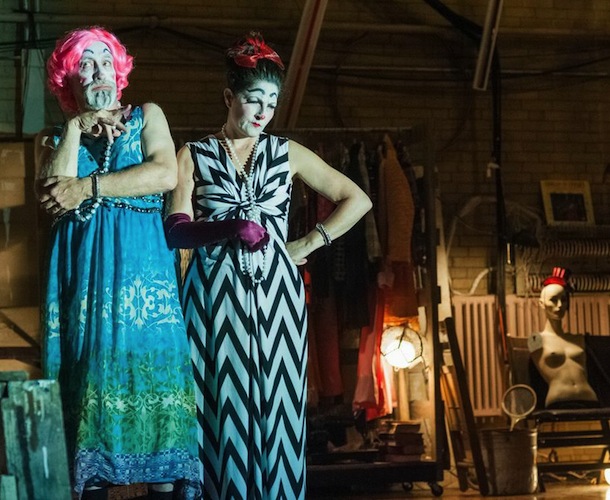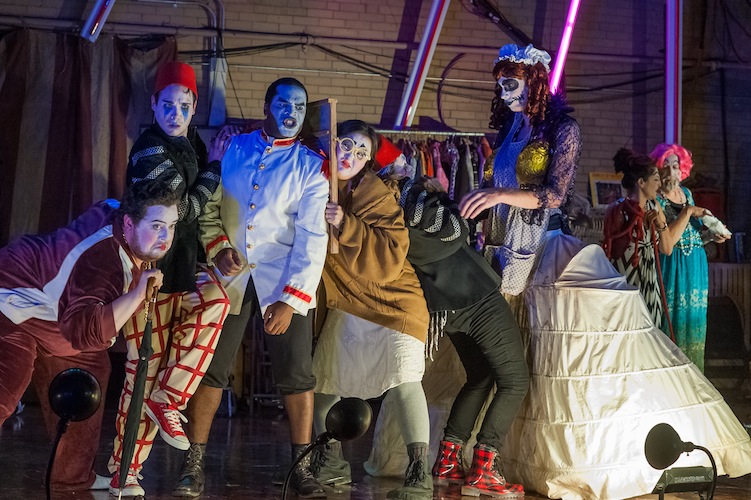Theater Review: This “Comedy of Errors” is an Exhilarating Circus of Desperation
The intriguing notion of a down-and-out clown troupe struggling with a classic text propels this superb production.
The Comedy of Errors, by William Shakespeare. Directed by David R. Gammons. Presented by Actors’ Shakespeare Project at Brighton High School Auditorium, Brighton MA., through October 19.

Richard Snee (Luciana) and Sarah Newhouse (Adriana) in the Actors’ Shakespeare Project’s production of “The Comedy of Errors.” Photo: Stratton McCrady.
By Ian Thal
Because it is one of Shakepeare’s most often performed plays, there is little point in recounting the plot of The Comedy of Errors. For those who need their memories jogged: it is the one in which two sets of identical twins, two masters and two servants, after being separated as infants during a storm at sea, are finally reunited at the end of one maddening day.
The play is also a bit of an oddity in the Shakespeare canon. Unlike most of his other comedies, it is not set in Italy but in the historically Ionian Greek city of Ephesus, which, by Shakespeare’s time had been abandoned after Anatolia had been conquered by the Turks. Perhaps because it borrows much of its plot from the Menaechmi by the Roman playwright, Plautus (c.254 BCE – 184 BCE) it is one of only two of Shakespeare’s plays that adheres to the classical unities of action, place, and time. The play is also a notable exception to my assertion that whereas the poetry of Shakespeare’s comedies are superior to Goldoni’s, the latter’s plots are always more complex and tightly constructed. Goldoni’s The Venetian Twins, which also takes some inspiration from Menaechmi, is not as meticulously constructed as The Comedy of Errors, written a little more than a century-and-a-half earlier.
In the Actors’ Shakespeare Project’s production, director David R. Gammons’s central conceit is that we are watching a down-on-its-luck troupe of clowns and side-show performers led by “Thee [sic] Amazing Siamese Twins” Snoo (Sarah Newhouse) and (Richard) Snee, themselves the stage names of Shauna Hewrose and Archie Snerd (note the anagrams) who are joined at the hip by a large metal clasp. The company, squatting in an abandoned theater, is putting on an under-rehearsed performance of the classic comedy. For Snoo & Snee, the show is a desperate attempt to rally behind some renewed purpose after a series of mishaps has reduced them to their current state. As such, the cast have developed clown characters who have their own attitudes to the new change in artistic direction.
Lazy Susan of Akron (Cameron M. Cronin), a clown who also poses as a bearded lady, has taken it upon himself to direct this adaptation, apologizing up front for the uneven quality of the performance. When he isn’t playing Angelo the goldsmith, the courtesan, and other small roles he corrects flubbed lines and poorly executed stage fights. Melissa Bigfoot (Paige Clarke), a hapless sad sack, finds herself struggling with the clown shoes that define her life. Zsaaz the Contorting Skeleton (Ryan O’Conner) seems to relish the crazy costumes called for in his roles as Nell, the greasy kitchen wench, Doctor Pinch, and a merchant. Likewise, Brawndo (Omar Robinson) can’t shake the machismo of his persona as the circus strongman — as he slowly struts into every scene, his body language suggesting he holds immense physical prowess in reserve. By contrast, Joe the Recently Escaped Escape Artist (Jesse Hinson) plays Antipholus of Syracuse as a man eager to get himself in and out of whatever trouble the script demands. The two Dromios, played by Blue the Tattooed Lady (Susan S. McGinnis) and Jacque Le Jacque (Eddie Shields) appear to be hewing close to the personae they’ve inhabited for years — clowns on the receiving end of the slapstick. Newhouse and Snee as the conjoined twins double as the two pairs that never appear without the other: Solinus, the Duke of Ephesus, and Egeon, the Syracusean father of the Antipholi, whom the Duke is pledged to execute if he cannot be ransomed; and Ephesian sisters Adriana and Luciana.
Clowning is one of the few acting traditions in the west which has resisted the pseudo-naturalism of modern drama. Virtuosic energy is the thing: broadness, wild ideas and visual puns, inventive use of props, mime, slapstick violence, and absurd costumes. Dovetailing clowning with Shakespeare’s rich language is not as incongruous than some might think. Shakespeare may have been the era’s most gifted exponent of poetic stage language, but its tropes were very familiar to the London audiences (even the groundlings), having heard and them in sermons and speeches, seen them in public pageants and morality plays, or read them in scripture, pamphlets, quartos and broadsides. Stylized clowning, rather than distracting from Shakespeare’s language, actually draws our attention to it, underlining many of the poetic tropes that would have been obvious to the audience at the earliest recorded performance of Comedy of Errors in 1594 at Gray’s Inn (one of the “Inns of Court” – professional associations of judges and barristers whose training included classical literature).
The notion of a clown troupe struggling with a classic text informs the visual and physical vocabulary of this production. It also provides a running commentary on the difficult act of making theater. Clarke’s Melissa Bigfoot lacks confidence with the new artistic direction and her own abilities, having spent so much time perfecting her big scenes as Emilia the Abbess of Ephesus, that she’s neglected to fully rehearse her role as a merchant. Meanwhile, Gammons has Cronin’s Lazy Susan, living up to his name, having neither planned out nor rehearsed the final act with his cast, so just as the Ephesians and Siracusani are resolving their confusion, some of the clowns discover that the doubling had not taken that sorting out into account.
Gammons’s use of theatrical clowning is particularly effective. Egeon’s monologue on the birth of his sons and their servants, followed by the loss of his wife and half of each pair at sea, is accompanied by an elaborate dumb show that introduces the troupe. In other scenes, absurd lazzi play out in the background, as when Adriana and Luciana savor a pair of toilet brushes as if they are the main course. Prop designer Nina Alexander is responsible for a number of clever substitutions: a washboard that serves as a foley effect in one scene and a household item in another becomes, in the hands of Clarke’s Melissa Bigfoot, a door baring entry to Robinson’s Antipholus; violins (a pun on violence) and bananas become guns; toilet plungers become swords and then morph back into plungers.
The slapstick violence, designed by Ted Hewlett, even when it cleverly dramatizes the ways that inconveniences visited upon masters trickle down as pains and humiliations for their servants, is accompanied by slide whistle and percussion. Only when the family of their masters is reunited and restored do the Dromios enjoy some degree of respect, even though Ephesus and Syracuse remain at war.
Gail Astrid Buckley’s costumes are entertainments in and of themselves: Nell’s skirts are supported by absurdly gigantic farthingales. Doctor Pinch struts about in platform shoes and a pharaoh’s red crown or deshret; one merchant conducts business in a zoot suit. Other characters stick to more traditional circus fare: there’s the mismatched motley of the lower status clowns and the cartooishly antiquated formal dress of the Antipholi and Dromios. Meanwhile, under the clothing of the Antipholi peep costumes in keeping with the roles they normally play in the circus.
Gammons, doubling as scenic designer, outfits the stage with haphazardly mounted posters and lighting effects, suggesting both the dilapidated condition of Snoo & Snee’s Sideshow’s latest home as well as the uncertainty about how long the troupe may be welcome.
The staging of The Comedy of Errors as a circus is not unprecedented. Some will remember the 1987 Lincoln Center production (directed by Robert Woodruff) that was broadcast on PBS stations featuring the Flying Karamazov Brothers, Avner “The Eccentric” Eisenberg and other clowns, jugglers, and circus performers. That 1987 production emphasized the virtuosity of its cast, and drew on the well-established stage personae of Karamazovs and of Avner. Gammons, by contrast, places his emphasis on palpable desperation, a sense of angst symbolized by Egeon’s death sentence and the possible end of Snoo & Snee’s company if this show does not succeed. In this imaginative unity of script, action, design, conceit, and theme, this staging of Comedy of Errors is one of Gammons’ more fully realized productions.
Note: It is very appropriate that ASP is staging the show at Brighton High School, given that so many of the Boston Public School’s auditoriums were built in an era when the performing arts were considered a vital part of a high school education. Of course, the spaces have been largely underutilized and neglected for decades. Kudos to ASP for their community engagement: on the night I attended some of the ushers were clearly students at Brighton.
Ian Thal is a performer and theatre educator specializing in mime, commedia dell’arte, and puppetry, and has been known to act on Boston area stages from time to time, sometimes with Teatro delle Maschere, and on occasion served on productions as a puppetry choreographer or dramaturg. He has performed his one-man show, Arlecchino Am Ravenous, in numerous venues in Massachusetts and Rhode Island, and is currently working on his second full length play; his first, though as-of-yet unproduced, was picketed by a Hamas supporter during a staged reading. Formally the community editor at The Jewish Advocate, he blogs irregularly at the unimaginatively entitled From The Journals of Ian Thal, and writes the “Nothing But Trouble” column for The Clyde Fitch Report.
Tagged: Actors' Shakespeare Project, ASP, David R. Gammons, The Comedy of Errors

